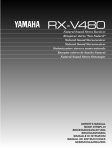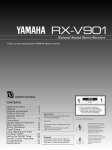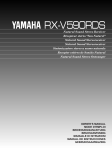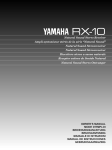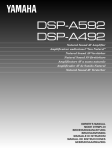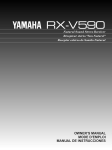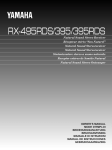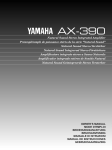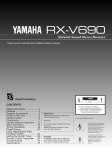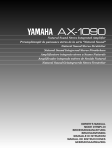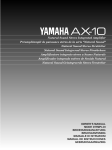Download Yamaha DSP-A590 Owner`s manual
Transcript
DSP-A590 Natural Sound Digital Sound Field Processing Amplifier Amplificateur de champ sonore numérique de la série “Natural Sound” Natural Sound Digitaler Klangfeldverstärker Digital ljudfältsförstärkare med naturligt ljud Amplificatore digitale a suono naturale per l’elaborazione del campo sonoro Amplificador de procesamiento de campo de sonido digital de Sonido natural Digitale geluidsveldprocessing-versterker met natuurlijke klank OWNER’S MANUAL MODE D’EMPLOI BEDIENUNGSANLEITUNG BRUKSANVISNING MANUALE DI ISTRUZIONI MANUAL DE INSTRUCCIONES GEBRUIKSAANWIJZING SUPPLIED ACCESSORIES ACCESSOIRES FOURNIS MITGELIEFERTE ZUBEHORTEILE MEDFOLJANDE TILLBEHOR ACCESSORI IN DOTAZIONE ACCESORIOS INCLUIDOS BIJGELEVERDE ACCESSOIRES ● ● ● ● ● ● ● Remote Control Transmitter Emetteur de télécommande Fernbedienungsgeber Fjärrkontrollsändare Telecomando Transmisor del control remoto Afstandbediening ● ● ● ● ● ● ● After unpacking, check that the following parts are included. Après le déballage, vérifier que les pièces suivantes sont incluses. Nach dem Auspacken überprüfen, ob die folgenden Teile vorhanden sind. Kontrollera efter det apparaten packats upp att följande delar finns med. Verificare che tutte le parti seguenti siano contenute nell’imballaggio dell’apparecchio. Desembale el aparato y verificar que los siguientes accesorios están en la caja. Controleer na het uitpakken of de volgende onderdelen voorhanden zijn. ● ● ● ● ● ● ● Batteries (size AA, R6, UM-3) Piles (taille AA, R6, UM-3) Batterien (Größe AA, R6, UM-3) Batterier (storlek AA, R6, UM-3) Batterie (dimensioni AA, R6, UM-3) Pilas (tamaño AA, R6, UM-3) Batterijen (maat AA, R6, UM-3) This product complies with the radio frequency interference requirements of the Council Directive 82/499/EEC and/or 87/308/EEC. Cet appareil est conforme aux prescriptions de la directive communautaire 87/308/CEE. Diese Geräte entsprechen der EG-Richtlinie 82/499/EWG und/oder 87/308/EWG. Dette apparat overholder det gaeldende EF-direktiv vedrørende radiostøj. Questo apparecchio è conforme al D.M.13 aprile 1989 (Direttiva CEE/87/308) sulla soppressione dei radiodisturbi. Este producto está de acuerdo con los requisitos sobre interferencias de radio frecuencia fijados por el Consejo Directivo 87/308 CEE. Dit product voldoet aan de EEG normen betreffende radio-frekwentie storingen 82/499/EEG en/of 87/308/EEG. 2 FEATURES ● 5 Speaker Configuration Front: 70W + 70W (8Ω) RMS Output Power, 0.04% THD, 20–20,000 Hz Center: 70W (8Ω) RMS Output Power, 0,07% THD, 20–20,000 Hz Rear: 20W + 20W (8Ω) RMS Output Power, 0.3% THD, 1 kHz ● Automatic Input Balance Control for Dolby Surround ● Digital Sound Field Processor 6 Programs for Digital Sound Field Processing 2 Programs for Dolby Surround Decoding (DOLBY PRO LOGIC and DOLBY PRO LOGIC ENHANCED) ● Video Signal Input/Output Capability (Including S Video Connections) English Thank you for selecting this YAMAHA digital sound field processing amplifier. ● Test Tone Generator for Easier Speaker Output Balance Adjustment ● 3 Center Channel Modes (NORMAL/WIDE/PHANTOM) ● SLEEP Timer ● Remote Control Capability CONTENTS Supplied Accessories ......................................2 Using Digital Sound Field Processor (DSP) ..18 Caution ............................................................4 Setting the SLEEP Timer ..............................22 Profile of This Unit ...........................................5 Remote Control Transmitter ..........................23 Speaker Setup for This Unit ............................6 Notes about the Remote Control Transmitter Connections ....................................................7 .......................................................................24 Speaker Balance Adjustment ........................12 Troubleshooting .............................................25 Basic Operations ...........................................15 Specifications ................................................26 3 CAUTION : READ THIS BEFORE OPERATING YOUR UNIT. 1. 2. To assure the finest performance, please read this manual carefully. Keep it in a safe place for future reference. Install this unit in a cool, dry, clean place – away from windows, heat sources, sources of excessive vibration, dust, moisture and cold. Avoid sources of humming (transformers, motors). To prevent fire or electrical shock, do not expose the unit to rain or water. 3. Never open the cabinet. If something drops into the set, contact your dealer. 4. Do not use force on switches, controls or connection wires. When moving the unit, first disconnect the power plug and the wires connected to other equipment. Never pull the wires themselves. 5. The openings on the cabinet assure proper ventilation of the unit. If these openings are obstructed, the temperature inside the cabinet will rise rapidly and eventually damage the circuits. Therefore, avoid placing objects against these openings and do not install the unit where the flow of air through the ventilation openings could be impeded. Serial No.: The serial number is located on the rear of the unit. Retain this Owner’s Manual in a safe place for future reference. WARNING TO REDUCE THE RISK OF FIRE OR ELECTRIC SHOCK, DO NOT EXPOSE THIS UNIT TO RAIN OR MOISTURE. The apparatus is not disconnected from the AC power source as long as it is connected to the wall outlet, even if the apparatus itself is turned off. For U.K. customers 6. Always set the VOLUME control to “– ∞” before starting the audio source play. Increase the volume gradually to an appropriate level after playback has been started. 7. Do not attempt to clean the unit with chemical solvents; this might damage the finish. Use a clean, dry cloth. If the socket outlets in the home are not suitable for the plug supplied with this appliance, it should be cut off and an appropriate 3 pin plug fitted. For details, refer to the instructions described below. Note: The plug severed from the mains lead must be destroyed, as a plug with bared flexible cord is hazardous if engaged in a live socket outlet. 8. Be sure to read the “TROUBLESHOOTING” section regarding common operating errors before concluding that the unit is faulty. Special Instructions for U.K. Model 9. When not planning to use this unit for long periods of time (ie., vacation, etc.), disconnect the AC power plug from the wall outlet. 10. To prevent lightning damage, disconnect the AC power plug and disconnect the antenna cable when there is an electrical storm. 11. Grounding or polarization – Precautions should be taken so that the grounding or polarization of an appliance is not defeated. 12. AC outlet Do not connect audio equipment to the AC outlet on the rear panel if that equipment requires more power than the outlet is rated to provide. 13. Voltage Selector (General Model only) The voltage selector on the rear panel of this unit must be set for your local main voltage BEFORE plugging into the AC main supply. Voltages are 110/120/220/240V AC, 50/60 Hz. 4 IMPORTANT Please record the serial number of this unit in the space below. IMPORTANT THE WIRES IN THE MAINS LEAD ARE COLOURED IN ACCORDANCE WITH THE FOLLOWING CODE: Blue: NEUTRAL Brown: LIVE As the colours of the wires in the main lead of this apparatus may not correspond with the coloured markings identifying the terminals in your plug, proceed as follows: The wire which is coloured BLUE must be connected to the terminal which is marked with the letter N or coloured BLACK. The wire which is coloured BROWN must be connected to the terminal which is marked with the letter L or coloured RED. Make sure that neither core is connected to the earth terminal of the three pin plug. You are the proud owner of a Yamaha stereo amplifier –an extremely sophisticated audio component. The Digital Sound Field Processor (DSP) built into this unit takes full advantage of Yamaha’s undisputed leadership in the field of digital audio processing to bring you a whole new world of listening experiences. Follow the instructions in this manual carefully when setting up your system, and this unit will sonically transform your room into a wide range of listening environments –movie theater, concert hall, and so on. In addition, you get incredible realism from Dolby-encoded video sources using the built-in Dolby Pro Logic Surround Decoder. Please read this operation manual carefully and store it in a safe place for later reference. English PROFILE OF THIS UNIT Digital Sound Field Processing What is it that makes live music so good? Today’s advanced sound reproduction technology lets you get extremely close to the sound of a live performance, but chances are you’ll still notice something missing: the acoustic environment of the live concert hall. Extensive research into the exact nature of the sonic reflections that create the ambience of a large hall has made it possible for Yamaha engineers to bring you this same sound in your own listening room, so you’ll feel all the sound of a live concert. What’s more, our technicians, armed with sophisticated measuring equipment, have even made it possible to capture the acoustics of a variety of venues such as an actual concert hall, theater, etc. to allow you to accurately recreate one of several actual live performance environments, all in your own home. Dolby Pro Logic Surround The Dolby Pro Logic Surround Decoder program lets you experience the dramatic realism and impact of Dolby Surround movie theater sound in your own home. Dolby Pro Logic gets its name from its professional-grade steering logic circuitry, which provides greater effective front and rear channel separation for a much higher degree of realism than the “passive” Dolby Surround circuits found in less sophisticated home audio/video equipment. Dolby Pro Logic Surround provides a true center channel, so that there are four independent channels, unlike passive Dolby Surround which has in effect only three channels: left, right, and rear. This center channel allows listeners seated in even less-than-ideal positions to hear the dialog originating from action on the screen while getting a stereo effect as well. Dolby Pro Logic Surround + DSP You can also enjoy a combination of Dolby Pro Logic Surround and DSP in the sound field program “ PRO LOGIC ENHANCED”. It recreates the surround effect of a movie theater, effectively duplicating its multiple surround loudspeaker system, completely surrounding the listener with the sounds of the action taking place on the screen. 5 SPEAKER SETUP FOR THIS UNIT SPEAKERS TO BE USED This unit is designed to provide the best sound-field quality with a 5 speaker configuration. The speakers to be used with this unit will be mainly front speakers, rear speakers, and a center speaker. (You can omit the center speaker. Refer to the “4-Speaker Configuration” shown below.) The front speakers are used for the main source sound and the effect sound. They will probably be the speakers of your present stereo speaker system. The rear speakers are used for the effect sound. And the center speaker is used for the center sound (dialog etc.) encoded with the Dolby Surround. The rear and center speakers do not need to be equal in power to the front speakers. However, all the speakers should have high enough power handling to accept the maximum output of this unit. SPEAKER CONFIGURATION 5-Speaker Configuration 4-Speaker Configuration This configuration is the most effective and recommended one. In this configuration, the center speaker is necessary as well as the rear speakers. If the digital sound field program DOLBY PRO LOGIC or DOLBY PRO LOGIC ENHANCED is selected, conversations will be output from the center speaker and the ambience will be excellent. ● Set the center channel mode to the “NORMAL” or “WIDE” position. (For details, refer to page 13.) The center speaker is not used in this configuration. If the digital sound field program DOLBY PRO LOGIC or DOLBY PRO LOGIC ENHANCED is selected, the center sound is output from the left and the right front speakers. However, the sound effect of other programs can be the same as that of the 5-speaker configuration. ● Be sure to set the center channel mode to the “PHANTOM” position. (For details, refer to page 13.) Front L Center Front R Front L Dialogue Dialogue Surround sound Surround sound Rear L Rear R Rear L Front R Rear R SPEAKER PLACEMENT The recommended speaker configuration, the 5-speaker configuration, will require two speaker pairs: front speakers (your normal stereo speakers), and rear speakers, plus a center speaker. When you place these speakers, refer to the following. Front: In normal position. (The position of your present stereo speaker system.) Rear: Behind your listening position, facing slightly inward. Nearly six feet (approx. 1.8 m) up from the floor. Center: Precisely between the front speakers. (To avoid interference with TV sets, use a magnetically shielded speaker.) Front R Center Front L TV set Rear R Rear L 6 Before attempting to make any connections to or from this unit, be sure to first switch OFF the power to this unit and to any other components to which connections are being made. English CONNECTIONS CONNECTIONS WITH OTHER COMPONENTS When making connections between this unit and other components, be sure all connections are made correctly, that is to say L (left) to L, R (right) to R, “+” to “+” and “–” to “–”. Also, refer to the owner’s manual for each component to be connected to this unit. LD player, TV tuner, etc. AUDIO IN VIDEO OUT AUDIO OUT VIDEO IN Video cassette recorder 2 VIDEO OUT VIDEO IN AUDIO OUT Monitor TV GND OUTPUT Turntable (Europe model) OUTPUT 8ΩMIN. /SPEAKER FRONT CENTER REAR REAR GND AC OUTLETS SWITCHED l20W MAX. TOTAL CENTER C D DUAL 8 VIDEO VCR 2 MONITOR IN OUT OUT C D:4ΩMIN./SPEAKER SINGLE:8ΩMIN./SPEAKER VIDEO SIGNAL MONITOR LD/TV OUT VCR 1 IN OUT VCR 2 IN OUT MAINS LOW PASS fc:200Hz SINGLE SPEAKERS SPEAKERS A A A OR B:8ΩMIN. /SPEAKER A B:l6ΩMIN. /SPEAKER B PHONO CD TUNER TAPE REC PB OUT TAPE IN LD/TV OUT VCR 1 IN B OUT VCR 2 -l0 dB 0 dB FRONT LEVEL FRONT AUDIO SIGNAL CD player Tuner Tape deck VIDEO IN AUDIO IN AUDIO OUT VIDEO OUT LINE IN LINE OUT OUTPUT OUTPUT To AC outlet Video cassette recorder 1 : Refer to “ABOUT THE ACCESSORY TERMINALS” on page 11. 7 CONNECTING TO S VIDEO TERMINALS If you have a video cassette recorder and a monitor equipped with “S” (high-resolution) video terminals, those terminals can be connected to this unit’s S VIDEO terminals. Connect the video cassette recorder’s “S” video input and output terminals to this unit’s S VIDEO VCR 2 IN and OUT terminals respectively, and connect the monitor’s “S” video input terminal to this unit’s S VIDEO MONITOR OUT terminal. Otherwise, connect the video cassette recorder’s composite video terminals to this unit’s composite video terminals, and connect the monitor’s composite video input terminal to this unit’s composite MONITOR OUT terminal. Note If video signals are sent to both S VIDEO input and composite input terminals, the signals will be sent to their respective output terminals independently. Monitor TV VIDEO SIGNAL VCR 1 OUT IN VCR 2 OUT VIDEO IN IN VIDEO OUT MONITOR LD/TV OUT S VIDEO IN S VIDEO VCR 2 MONITOR OUT IN OUT S VIDEO OUT S VIDEO IN VIDEO IN Video cassette recorder 2 CONNECTING TO VIDEO AUX TERMINALS (ON THE FRONT PANEL) These terminals are used to connect any video input source such as a camcorder to this unit. VIDEO AUX S VIDEO VIDEO L AUDIO R AUDIO OUT R R AUDIO OUT L VIDEO OUT L VIDEO Camcorder S VIDEO OUT S VIDEO 8 English CONNECTING SPEAKERS Connect the respective speakers to this unit as figured below. Rear speakers Left Right OUTPUT 8ΩMIN. /SPEAKER FRONT CENTER REAR REAR CENTER C D DUAL C D:4ΩMIN./SPEAKER SINGLE:8ΩMIN./SPEAKER LOW PASS fc:200Hz SINGLE SPEAKERS SPEAKERS A A A OR B:8ΩMIN. /SPEAKER A B:l6ΩMIN. /SPEAKER B B Center speaker -l0 dB 0 dB FRONT LEVEL FRONT Left Right FRONT LEVEL switch (U.K., Europe and Australia models) Front speakers A Left Right Front speakers B Note on front speaker connection: Note on center speaker connection: One or two speaker systems can be connected to this unit. If you connect only one speaker system, connect it to either the SPEAKERS A or B terminals. One or two center speakers can be connected to this unit. If you cannot place the center speaker on or under the TV, it is recommended to use two center speakers and place them on both sides of the TV to orient the center sound at the center position. For connecting two center speakers, follow the method shown below. REAR FRONT LEVEL switch <U.K., Europe and Australia models only> Normally set to “0 dB”. If desired, you can decrease the output level at the FRONT SPEAKERS terminals by 10 dB by setting this switch to “–10 dB”. CENTER C D DUAL SINGLE l l0 dB 0 dB FRONT LEVEL Center speaker Center speaker 9 How to Connect: Connect the SPEAKERS terminals to your speakers with wire of the proper gauge, cut as short as possible. If the connections are faulty, no sound will be heard from the speakers. Make sure that the polarity of the speaker wires is correct, that is, + and – markings are observed. If these wires are reversed, the sound will be unnatural and will lack bass. Do not let the bare speaker wires touch each other and do not let them touch the metal parts of this unit as this could damage this unit and/or speakers. Note Use speakers with the specified impedance shown on the rear of this unit. For connecting to the FRONT SPEAKERS terminals Red: positive (+) Black: negative (–) For connecting to the REAR and CENTER SPEAKERS terminals Red: positive (+) Black: negative (–) ➀ Unscrew the knob. ➁ Insert the bare wire. 2 1 [Remove approx. 5mm (1/4”) insulation from the speaker wires.] ➂ Tighten the knob and secure the wire. ➀ Press up the tab. ➁ Insert the bare wire. ➀ ➂ 3 ➁ * <General model only> Banana Plug connections are also possible. Simply insert the Banana Plug connector into the corresponding terminal. 10 [Remove approx. 5mm (1/4”) insulation from the speaker wires.] ➂ Release the tab and secure the wire. English ABOUT THE ACCESSORY TERMINALS AC OUTLET(S) (SWITCHED) FRONT OUTPUT terminals (Europe and General models) .......... 2 SWITCHED OUTLETS (U.K. and Australia models) ................ 1 SWITCHED OUTLET Use these to connect the power cords from your components to this unit. The power to the SWITCHED outlets is controlled by this unit’s POWER switch or the provided remote control transmitter’s POWER key. These outlets will supply power to any component whenever this unit is turned on. The maximum power (total power consumption of components) that can be connected to the SWITCHED AC OUTLET(S) is 120 watts. These terminals are for front channel line output. There is no connection to these terminals when you use the built-in amplifier. However, if you drive front speakers with an external stereo power amplifier, connect the input terminals of the external amplifier (MAIN IN or AUX terminals of a power amplifier or an integrated amplifier) to these terminals. REAR OUTPUT terminals Connecting the ground wire of the turntable to this terminal will normally minimize hum, but in some cases better results may be obtained with the ground wire disconnected. These terminals are for rear channel line output. There is no connection to these terminals when you use the built-in amplifier. However, if you drive rear speakers with an external stereo power amplifier, connect the input terminals of the external amplifier (MAIN IN or AUX terminals of a power amplifier or an integrated amplifier) to these terminals. LOW PASS terminal CENTER OUTPUT terminal This terminal is for output to a monaural amplifier driving a subwoofer. Only frequencies below 200 Hz from the front and center channels are output. This terminal is for center channel line output. There is no connection to this terminal when you use the built-in amplifier. However, if you drive a center speaker with an external power amplifier, connect the input terminal of the external amplifier to this terminal. GND terminal (For turntable use) ADDING A SUBWOOFER You may wish to add a subwoofer to reinforce the bass frequencies. Connect the LOW PASS terminal to the INPUT terminal of the subwoofer amplifier, and connect the speaker terminals of the subwoofer amplifier to the subwoofer. With some subwoofers, including the Yamaha Active Servo Processing Subwoofer System, the amplifier and subwoofer are in the same unit. OUTPUT FRONT CENTER REAR LOW PASS fc:200Hz Subwoofer system 11 SPEAKER BALANCE ADJUSTMENT This procedure lets you adjust the sound output level balance between the front, center, and rear speakers using the built-in test tone generator. With this adjustment, the sound output level heard at the listening position will be the same from each speaker. This is important for the best performance of the digital sound field processor. The adjustment of each speaker output level should be done at your listening position with the remote control transmitter. Otherwise, the result may not be satisfactory. 1 5 4 REC PAUSE DIR A PLAY TEST 1 4 5 Set to the “ ∞ ” position. VCR 2 EFFECT ON/OFF V AUX VOLUME DELAY TIME POWER Select the PRO LOGIC or PRO LOGIC ENHANCED mode, so that the corresponding name is illuminated on the display. Select the front speakers to be used. SPEAKERS EFFECT A B ON ON OFF OFF * If you use two front speaker systems, press both the A and B switches. 3 BASS l 0 TREBLE l 2 l 2 3 3 4 4 5 5 0 BALANCE l 2 l 2 3 3 4 4 5 5 Set to the “0” position. 12 HALL DISCO 3 2 2 5 VCR 1 SUR. MONO MOVIE STADIUM ROCK REAR LEVEL TAPE MON LD/TV ENHANCED CNCT VIDEO PRO LOGIC CENTER LEVEL DIR B STOP 0 l 2 2 3 3 4 4 L 5 5 R PRO LOGIC ENHANCED CONCERT VIDEO MONO MOVIE STADIUM DISCO ROCK CONCERT CONCERT HALL English 8 6 REC PAUSE 7 DIR A PLAY TEST STOP CENTER LEVEL MONO MOVIE STADIUM PRO LOGIC TAPE MON LD/TV ENHANCED CNCT VIDEO VCR 1 SUR. ROCK REAR LEVEL DIR B HALL DELAY TIME DISCO VCR 2 EFFECT ON/OFF V AUX VOLUME 8 6 Select the center channel output mode according to your speaker configuration. (Refer to “SPEAKER CONFIGURATION” on page 6.) CENTER MODE 7 TEST TEST ER Flashes continuously. NORMAL WIDE 8 Turn up the volume. PHANTOM VOLUME On the feature of each mode, refer to the “Note” shown below. Note In step 6, when you select the center channel output mode, note the following. For 5 speaker configuration) NORMAL: Select this mode when you use a center speaker that is smaller than the front speakers. In this mode, the bass tone will be output from the front speakers. WIDE: Select this mode when you use the center speaker approximately same sized as the front speakers. You will hear a test tone (like pink noise) from the left front speaker, then the center speaker, then the right front speaker, and then the rear speakers, for about two seconds each. The display changes as shown below. Front (L) Center TEST For 4 speaker configuration) PHANTOM: Select this mode when you do not use the center speaker. The center sound will be output from the left and right front speakers. Rear (L and R) Front (R) * The test tone from the left rear speaker and the right rear speaker will be heard at the same time. CONTINUED 13 REC PAUSE 12 10 11 DIR A TEST PRO LOGIC CENTER LEVEL DIR B TAPE MON LD/TV ENHANCED CNCT VIDEO VCR 1 SUR. MONO MOVIE STADIUM ROCK REAR LEVEL PLAY STOP HALL DELAY TIME DISCO VCR 2 EFFECT ON/OFF V AUX VOLUME 9 9 12 Adjust the BALANCE control so that the effect sound output level of the left front speaker and the right front speaker are the same. Cancel the test tone. TEST TEST R BALANCE l 0 l 2 2 3 3 4 L 5 10 Stops flashing and disappears 4 5 R Adjust the sound output level of the center speaker to be at the same level as that of the front speakers with the CENTER LEVEL keys. Lights up. TEST CENTER LEVEL CENTER 00 Adjustable 11 Adjust the sound output level of the rear speakers to be at the same level as that of the front speakers with the REAR LEVEL keys. Lights up. TEST REAR LEVEL 0 REAR Adjustable 14 Notes Once you have completed these adjustments, you can adjust whole sound level on your audio system by using the VOLUME control (or the VOLUME keys on the remote control transmitter). ● If you use external power amplifiers, their volume controls may also be adjusted to achieve proper balance. ● In step 10, if the center channel mode is in the “PHANTOM” position, the sound output level of the center speaker cannot be adjusted. This is because in this mode, the center sound is automatically output from the left and right front speakers. ● <U.K., Europe and Australia models only> If there is insufficient sound output from the center and rear speakers, you may decrease the front speaker output level by setting the FRONT LEVEL switch on the rear panel to “–10 dB”. ● 7 2 4 3 1, 6 English BASIC OPERATIONS 7 TO PLAY A SOURCE 1 5 Play the source. 6 Set to the “ ∞ ” position. 2 POWER Adjust to the desired output level. 7 3 Select the desired input source by using the input selector buttons. (For video sources, turn the TV/monitor ON.) TAPE MONITOR TUNER CD PHONO VIDEO AUX VCR 2 VCR 1 LD/TV * The name of the selected input source will appear in the display. 4 Select the front speakers to be used. SPEAKERS A B ON ON OFF OFF If desired, adjust the BASS, TREBLE, BALANCE controls, etc. (refer to page 17) and use the digital sound field processor. (Refer to page 20.) Notes on using the input selector buttons Note that pressing on each input selector button selects the source which is connected to the corresponding input terminals on the rear panel. * To select the source connected to the VIDEO AUX terminals on the front panel, press VIDEO AUX. ● The selection of TAPE MONITOR cannot be canceled by pressing another input selector button. To cancel it, press TAPE MONITOR again. When you select a button other than TAPE MONITOR, make sure that TAPE MONITOR is not also selected. ● If you select the input selector button for a video source without canceling the selection of TAPE MONITOR, the playback result will be the video image from the video source and the sound from the audio tape. ● Once you play a video source, its video image will not be interrupted even if the input selector button for an audio source is selected. ● To turn off the power Press the POWER switch again. * If you use two front speaker systems, press both the A and B switches. 15 1, 4 2 TO RECORD A SOURCE TO TAPE (OR DUB FROM TAPE TO TAPE) 1 2 3 4 16 Note DSP, VOLUME, BASS, TREBLE and BALANCE control settings have no effect on the material being recorded. Select the source to be recorded. TAPE MONITOR TUNER CD PHONO VIDEO AUX VCR 2 VCR 1 LD/TV Play the source and then turn the VOLUME control up to confirm the input source. Set the tape deck or VCR to the recording mode. If the tape deck is used for recording, you can monitor the sounds being recorded by pressing TAPE MONITOR. TAPE MONITOR TUNER CD PHONO VIDEO AUX VCR 2 VCR 1 LD/TV Because one or two speaker systems (as front speakers) can be connected to this unit, the SPEAKERS switches allow you to select speaker system A or B, or both at once. Adjusting the BASS and TREBLE controls BASS l 0 TREBLE l 2 SPEAKERS A B ON ON OFF OFF 3 3 4 BASS l 2 4 5 English Selecting the SPEAKER system 5 0 l 2 2 3 3 4 4 5 5 : Turn this clockwise to increase (or counterclockwise to decrease) the low frequency response. Adjusting the BALANCE control Adjust the balance of the output volume to the left and right speakers to compensate for sound imbalance caused by speaker location or listening room conditions. BALANCE l 0 l 2 2 3 TREBLE : Turn this clockwise to increase (or counterclockwise to decrease) the high frequency response. Note These controls are effective only for the sound from the front speakers. 3 4 4 L 5 5 R Note This control is effective only for the sound from the front speakers. When you listen with headphones PHONES Connect the headphones to the PHONES jack. You can listen to the sound to be output from the front speakers through headphones. When listening with headphones privately, set both the SPEAKERS A and B switches to the OFF position and switch off the digital sound field processor (so that no DSP program name is illuminated on the display) by pressing the EFFECT switch. 17 USING DIGITAL SOUND FIELD PROCESSOR (DSP) This unit incorporates a sophisticated, multi-program digital sound field processor, which allows you to expand and shape the audio sound field from both the audio and video sources, for a theater-like experience in the listening/viewing room. This digital sound field processor has 8 programs; 6 programs for digital sound field processing and 2 programs for the Dolby Pro Logic Surround sound system (DOLBY PRO LOGIC and DOLBY PRO LOGIC ENHANCED). You can create an excellent audio sound field by selecting the suitable program and adding desired adjustments. In addition, when the DOLBY PRO LOGIC or DOLBY PRO LOGIC ENHANCED program is selected, the built-in automatic input balance control functions. This presents you the best surround condition without manual adjustment. Front Panel Displays your selection on the DSP or other informations. TEST SLEEP DELAY CENTER REAR TAPE MONITOR NORMAL WIDEPHANTOM EFFECT PRO LOGIC ENHANCED CONCERT VIDEO MONO MOVIE CENTER MODE Switches on/off the digital sound field processor (DSP) ms PRO LOGIC CONCERT MONO STADIUM ROCK CONCERT ENHANCED VIDEO MOVIE DISCO CONCERT HALL STADIUM DELAY TIME DISCO ROCK CONCERT CENTER LEVEL CONCERT HALL REAR LEVEL Selects a digital sound field program. Selects the center channel output mode. (For details, refer to page 13.) Adjusts sound output level at each speaker. (For details, refer to Adjusts the delay time. page 20 and 21.) (For details, refer to page 21.) Remote Control Transmitter POWER SLEEP PHONO DISC SKIP SKIP Used for speaker balance adjustment (For details, refer to page 12, 13 and 14.) DECK A/B REC PAUSE PAUSE/STOP PRESET DIR A STOP CENTER LEVEL MONO MOVIE STADIUM PRO LOGIC Adjusts sound output level at each speaker. (For details, refer to page 20 and 21.) PLAY TEST CD TUNER DIR B TAPE MON LD/TV ENHANCED CNCT VIDEO Selects a digital sound field program. VCR 1 SUR. ROCK REAR LEVEL PLAY A/B/C/D/E HALL DELAY TIME DISCO VCR 2 EFFECT ON/OFF V AUX VOLUME Switches on/off the digital sound field processor (DSP). Adjusts the delay time. (For details, refer to page 21.) 18 English Description of Each Sound Field Program The following list gives brief descriptions of the sound fields produced by each of the DSP programs. Keep in mind that most of these are precise digital recreations of actual acoustic environments. The data for them was recorded at the locations described using sophisticated sound field measurement equipment. Note The channel level balance between the left rear effect speaker and the right rear effect speaker may vary depending on the sound field you are listening to. This is due to the fact that most of these sound field recreations are actual acoustic environments. PROGRAM PRO LOGIC PRO LOGIC ENHANCED FEATURE This program is effective for playback of sources encoded with Dolby Surround. The employment of the digital signal processing system improves crosstalk and transfers the sound source more smoothly and precisely, compared to the conventional type. A stable movie sound field is recreated. This program is effective for playback of sources encoded with Dolby Surround. Enhancing the “Normal” Dolby Pro Logic, the DSP technology simulates the multi-surround speaker systems of a 35 mm film theater, thus widening the surrounded-sound field with greater presence. CONCERT VIDEO This program is effective for music videos and gives excellent depth and clarity for vocals. For opera, the orchestra and stage are ideally recreated, letting you feel as if you were in an actual concert hall. MONO MOVIE This program is designed specifically to enhance mono source programs. Compared to a strictly mono setting, the sound image created in this mode is wider and slightly forward of the speaker pair, lending an immediacy to the overall sound. It is particularly effective when used with old mono movies, news broadcasts and dialog. STADIUM DISCO This program gives you long delays between direct sounds and effect sounds, and extraordinarily spacious feel of a large stadium. This program recreates the acoustic environment of a lively disco in the heart of a very lively city. The sound is dense and highly concentrated. It is also characterized by a high-energy, “immediate” sound. ROCK CONCERT This program is suitable for rock music. A big, powerful sound is reproduced lively and dynamically. CONCERT HALL In this program, the center seems deep behind the front speaker pair, creating an expansive, large hall ambience. Description of Dolby Pro Logic Surround DOLBY PRO LOGIC SURROUND: This unit employs the Dolby Pro Logic Surround system. This system is similar to professional Dolby Stereo decoders used in movie theaters. By employing a four-channel system, the Dolby Pro Logic Surround system divides the input signals into four levels: the left and right main channels, the center channel (to characterize dialog), and the rear surround-sound channels (to characterize sound effects, background noise and other ambient noise). Dolby Surround is encoded on the sound track of commercially available video cassettes and video discs as well. When you play a source encoded with Dolby Surround on your home video system, the Dolby Pro Logic Surround system in this unit decodes the signal and feeds the surround-sound effects. The Dolby Pro Logic Surround mode may not be always effective on video sources not encoded with Dolby Surround. Manufactured under license from Dolby Laboratories Licensing Corporation. Additionally licensed under Canadian patent number 1,037,877. “Dolby”, “Pro Logic”, and the double-D symbol are trademarks of Dolby Laboratories Licensing Corporation. 19 To play a source with the digital sound field processor REC PAUSE DIR A TEST PRO LOGIC CENTER LEVEL 1 2 TAPE MON LD/TV ENHANCED CNCT VIDEO MONO MOVIE STADIUM HALL DELAY TIME 3 2 DIR B VCR 1 SUR. ROCK REAR LEVEL PLAY STOP DISCO VCR 2 EFFECT ON/OFF V AUX 2 VOLUME 3 3 Follow steps 1 – 6 shown in “BASIC OPERATIONS” on page 15. If desired, adjust the delay time and the output level of each speaker. (For details, refer to the corresponding descriptions on this page and the next page.) Select the desired program that is suitable for the source. EFFECT PRO LOGIC ENHANCED CONCERT VIDEO MONO MOVIE STADIUM DISCO ROCK CONCERT CONCERT HALL Notes ● If you prefer to cancel the DSP, press the EFFECT switch. The sound will be the normal 2-channel stereo without surround sound effect. ● When CONCERT VIDEO, MONO MOVIE, STADIUM, DISCO, ROCK CONCERT or CONCERT HALL is selected, no sound is heard from the center speaker. ● When a monaural sound source is played with DOLBY PRO LOGIC or DOLBY PRO LOGIC ENHANCED, no sound is heard from the front speakers and the rear speakers. Sound is heard only from the center speaker. However, if the center channel mode is in PHANTOM, the front speakers output the sound of the center channel. ● When this unit’s Dolby Pro Logic Surround system is used, if the main-source sound is considerably altered by overadjustment of the BASS or TREBLE controls, the relationship between the center and rear channels may produce an unnatural effect. PRO LOGIC The selected program name is shown on the display. * The following adjustments can be done on the remote control transmitter as well as on the front panel. Adjustment of the CENTER LEVEL If desired, you can adjust the sound output level of the center speaker even if the output level is already set in “SPEAKER BALANCE ADJUSTMENT” on page 14. By continuously pressing “+” or “–” on the CENTER LEVEL control, the level value changes continuously. However, the value stops changing momentarily at the preset point (80). ● If the digital sound field program CONCERT VIDEO, MONO MOVIE, STADIUM, DISCO, ROCK CONCERT or CONCERT HALL is selected, the CENTER LEVEL control cannot function. ● Once the output level is adjusted, the level value will be the same in the DOLBY PRO LOGIC and DOLBY PRO LOGIC ENHANCED programs. ● If a digital sound field program is not used, the CENTER LEVEL control will not function. Lights up. CENTER LEVEL CENTER Adjustable 20 English Adjustment of the REAR LEVEL If desired, you can adjust the sound output level of the rear speakers even if the output level is already set in “SPEAKER BALANCE ADJUSTMENT” on page 14. Lights up. By continuously pressing “+” or “–” on the REAR LEVEL control, the level value changes continuously. However, the value stops changing momentarily at the preset point (80). ● Once the output level is adjusted, the level value will be the same in all the digital sound field programs. ● If DOLBY PRO LOGIC or a digital sound field program is not used, the REAR LEVEL control will not function. REAR LEVEL REAR Adjustable Adjustment of DELAY TIME You can adjust the time difference between the beginning of the source sound and the beginning of the effect sound with the DELAY TIME control. The DELAY TIME control is effective with all programs. By applying more or less delay, sound effects, background noise, and ambient noise coming at you from the rear speakers can be enhanced or subdued for extra effect. 1. PRO LOGIC : from 15 to 30 milliseconds (Preset value: 20 milliseconds) 2. PRO LOGIC : from 15 to 30 milliseconds ENHANCED (Preset value: 20 milliseconds) 3. CONCERT VIDEO : from 1 to 100 milliseconds (Preset value: 28 milliseconds) 4. MONO MOVIE : from 1 to 100 milliseconds (Preset value: 20 milliseconds) 5. STADIUM : from 1 to 50 milliseconds (Preset value: 45 milliseconds) 6. DISCO : from 1 to 100 milliseconds (Preset value: 14 milliseconds) 7. ROCK CONCERT : from 1 to 100 milliseconds (Preset value: 17 milliseconds) 8. CONCERT HALL : from 1 to 100 milliseconds (Preset value: 30 milliseconds) By continuously pressing “+” or “–” on the DELAY TIME control, the value changes continuously. However, the value stops changing momentarily at the preset point. Adjustable DELAY TIME STEREO DELAY 0 20 l00 ms ONCERT VIDEO Note Adding too much delay will cause an unnatural effect with some sources. Experiment with the DELAY TIME control to create the effect that you find most suitable. Note The values of the DELAY TIME, CENTER LEVEL and REAR LEVEL you set the last time will remain memorized even when the power of this unit is off. However, if the power cord is kept disconnected for more than one week, these values will be automatically changed back to the original factory settings. 21 SETTING THE SLEEP TIMER If you use the SLEEP timer of this unit, you can make this unit turn off automatically. When you are going to sleep while enjoying a broadcast or other desired input source, this timer function is helpful. Notes ● The SLEEP timer can be controlled only with the remote control transmitter. ● The components on which the SLEEP timer is effective are the sources connected to the SWITCHED AC OUTLET(S) on the rear panel of this unit. To set the SLEEP time To cancel the selected SLEEP time 1 SLEEP SLEEP Press once or more to select the desired SLEEP time. Press once or more so that the display returns to the indication before the SLEEP timer is set. (“SLEEP” will go off from the display.) Indicates the SLEEP time. Note The SLEEP timer setting can also be canceled by turning off the power with the POWER switch or disconnecting the power plug of this unit from the AC outlet. SLEEP ms l00 T Flashes on and off continuously. Whenever the SLEEP key is pressed, the SLEEP time will change as follows. (Minutes) 120 90 60 30 The SLEEP timer is OFF. (The indication before the SLEEP key is pressed.) After a while, the display returns to the indication before the SLEEP timer is set, and the “SLEEP” indicator stops flashing and lights up. 2 22 The unit will be turned off automatically at the selected SLEEP time. The remote control transmitter provided with this unit is designed to control all the most commonly used functions of the unit. If the CD player, tuner and tape deck connected to this unit are YAMAHA components, then this remote control transmitter will also control various functions of each component. English REMOTE CONTROL TRANSMITTER KEY FUNCTIONS For Control of This Unit * Refer to “SETTING THE SLEEP TIMER” on the previous page. POWER SLEEP PHONO DISC SKIP Turns the power on/off. SKIP PAUSE/STOP DECK A/B REC PAUSE PRESET DIR A TEST CD A/B/C/D/E TUNER DIR B TAPE MON STOP PRO LOGIC CENTER LEVEL PLAY PLAY LD/TV ENHANCED CNCT VIDEO Selects input source. VCR 1 SUR. MONO MOVIE STADIUM ROCK REAR LEVEL HALL DELAY TIME DISCO VCR 2 EFFECT ON/OFF V AUX VOLUME Turns the master volume level up/down. * For the DSP control keys, refer to the page 18. For Other Component Control Identify the remote control transmitter keys with your component’s keys. If these keys are identical, their function will be the same. On each key function, refer to the corresponding instruction on your component’s manual. Controls the compact disc player. * DISC SKIP is applicable only to a compact disc changer. POWER SLEEP PHONO DISC SKIP SKIP DECK A/B Controls the tape deck. * DIR A, B and DECK A/B are applicable only to a double cassette tape deck. * For a single cassette deck with automatic reverse function, pressing DIR A will reverse the direction of tape running. REC PAUSE PAUSE/STOP PRESET DIR A PLAY TEST STOP CENTER LEVEL MONO MOVIE STADIUM PRO LOGIC CD TUNER DIR B TAPE MON LD/TV ENHANCED CNCT VIDEO VCR 1 SUR. ROCK REAR LEVEL PLAY A/B/C/D/E HALL DELAY TIME DISCO VCR 2 EFFECT ON/OFF V AUX Controls the tuner. * +: Selects higher preset station number. –: Selects lower preset station number. A/B/C/D/E: Selects the page (A – E) of preset stations. VOLUME 23 STANDBY mode (U.K. and Europe models only) While the power is on, pressing the POWER key on the remote control transmitter switches the unit to the STANDBY mode. (In this mode, the indicator is half illuminated.) POWER on mode STANDBY mode NOTES ABOUT THE REMOTE CONTROL TRANSMITTER Battery installation Remote control transmitter operation range 1 3 Remote control sensor 2 Within approximately 6 m (19.7 feet) 30° 30° Battery replacement If you find that the remote control transmitter must be used closer to the main unit, the batteries are weak. Replace both batteries with new ones. Notes ● Use only AA, R6, UM-3 batteries for replacement. ● Be sure the polarities are correct. (See the illustration inside the battery compartment.) ● Remove the batteries if the remote control transmitter will not be used for an extended period of time. ● If batteries leak, dispose of them immediately. Avoid touching the leaked material or letting it come in contact with clothing, etc. Clean the battery compartment thoroughly before installing new batteries. 24 Notes ● There should be no large obstacles between the remote control transmitter and the main unit. ● If the remote control sensor is directly illuminated by strong lighting (especially an inverter type of fluorescent lamp etc.), it might cause the remote control transmitter not to work correctly. In this case, reposition the main unit to avoid direct lighting. If the unit fails to operate normally, check the following points to determine whether the fault can be corrected by the simple measures suggested. If it cannot be corrected, or if the fault is not listed in the SYMPTOM column, disconnect the power cord and contact your authorized YAMAHA dealer or service center for help. SYMPTOM CAUSE REMEDY The unit fails to turn on when the POWER switch is pressed. Power cord is not plugged in or is not completely inserted. Firmly plug in the power cord. No sound or no picture. Incorrect output cord connections. Connect the cords properly. If the problem persists, the cords may be defective. Appropriate input selector is not pressed. Press the appropriate input selector corresponding to the input source. The protection circuit has been activated because of short circuit etc. Turning the unit off and then on will reset the protection circuit. The SLEEP timer functioned. Do not make the SLEEP timer function. Only one side speaker outputs the sound. Incorrect setting of the BALANCE control. Adjust it to the appropriate position. Incorrect cord connections. Connect the cords properly. If the problem persists, the cords may be defective. Sound “hums”. Incorrect cord connections. Firmly connect the audio plugs. If the problem persists, the cords may be defective. No connection from the turntable to the GND terminal. Make the GND connection between the turntable and this unit. The volume level is low while playing a record. The record is being played on a turntable with an MC cartridge. The player should be connected to the unit through the MC head amplifier. The volume level cannot be increased, or sound is distorted. The power to the component connected to the REC OUT terminals of this unit is off. Turn the power to the component on. No sound from the rear speakers. The sound output level to the rear speakers is set to 0. Turn up the sound output level with the REAR LEVEL control. The monaural sound source is played in DOLBY PRO LOGIC or DOLBY PRO LOGIC ENHANCED mode. Select another program suitable for the monaural sound source. The sound output level to the center speaker is set to 0. Turn up the sound output level with the CENTER LEVEL control. The center channel mode is in PHANTOM mode. Select NORMAL or WIDE. The sound suddenly goes off. No sound from the center speaker. English TROUBLESHOOTING Incorrect sound field program selection. Select the appropriate program. No sound field program is selected. The remote control transmitter does not work. The sound is degraded when monitoring is performed by using the headphones connected to the compact disc player or cassette deck which are connected with this unit. Direct sunlight or lighting (of an inverter type of flourescent lamp etc.) is striking the remote control sensor of the main unit. Change the position of the main unit. The batteries of this remote control transmitter are too weak. Replace the batteries with new ones. The power to this unit is off. Turn the power to this unit on. 25 SPECIFICATIONS AUDIO SECTION Minimum RMS Output Power per Channel Front L, R 8 ohms, 20 Hz to 20 kHz, 0.04% THD ....................70W+70W Center 8 ohms, 20 Hz to 20 kHz, 0.07% THD .............................70W Rear L, R 8 ohms, 1 kHz, 0.3% THD .....................................20W+20W Maximum Output Power [General model only] 8 ohms, 1 kHz, 10% THD (FRONT L/R)............105W+105W Dynamic Power per Channel (by IHF Dynamic Headroom measuring method) 8/6/4/2 ohms ..............................................95/120/150/170W DIN Standard Output Power per Channel 4 ohms, 1 kHz, 0.7% THD [Europe model only] ....................................................100W IEC Power 8 ohms, 1 kHz, 0.1% THD [Europe model only] ......................................................78W Power Band Width 8 ohms, 30W, 0.08% THD ............................10 Hz to 50 kHz Damping Factor (SPEAKERS A) 8 ohms, 20 Hz to 20 kHz.......................................80 or more Input Sensitivity/Impedance PHONO MM ..............................................2.5 mV/47 k-ohms CD/TAPE/TUNER/LD·TV/VCR..................150 mV/47 k-ohms Maximum Input Signal (1 kHz, 0.5% THD) PHONO MM ...............................................................115 mV CD/TAPE/TUNER/LD·TV/VCR (EFFECT ON) .................2.2V Output Level/Impedance REC OUT ................................................150 mV/1.0 k-ohms PRE OUT......................................................2.2V/1.2 k-ohms LPF (EFFECT OFF) ......................................3.5V/1.5 k-ohms Headphone Jack Rated Output/Impedance Output Level (8 ohms, 1 kHz, 150 mV ) ..........................0.5V Impedance............................................................390 ohms Frequency Response (20 Hz to 20 kHz) CD/TAPE/TUNER/LD·TV/VCR (FRONT L/R)............0±0.5 dB RIAA Equalization Deviation PHONO MM .............................................................0±0.5 dB Total Harmonic Distortion PHONO MM to REC OUT 20 Hz to 20 kHz, 1V........................................0.02% or less CD/TAPE/TUNER/LD·TV/VCR to SP OUT FRONT L/R (EFFECT OFF) 20 Hz to 20 kHz, 30W/8 ohms .....................0.02% or less REAR L/R 1 kHz, 10W/8 ohms ........................................0.3% or less Signal-to-Noise Ratio (IHF-A Network) PHONO MM to REC OUT (5 mV Input Shorted) [U.K. and Europe models] ..........................................82 dB [Australia and General models]..................................85 dB CD/TAPE/TUNER/LD·TV/VCR to SP OUT (Input Shorted, EFFECT OFF) .................................................99 dB or more 26 Residual Noise (IHF-A Network) FRONT L/R......................................................140 µV or less Channel Separation (Vol. –30 dB, EFFECT OFF) PHONO MM (Input Shorted 1 kHz/10 kHz) ...............................................60 dB or more/50 dB or more CD/TAPE/TUNER/LD·TV/VCR (Input 5.1 k-ohms Shorted 1 kHz/10 kHz) ...............................................60 dB or more/44 dB or more Tone Control Characteristics BASS: Boost/cut .............................±10 dB (50 Hz) Turnover Frequency ......................(350 Hz) TREBLE: Boost/cut ...........................±10 dB (20 kHz) Turnover Frequency .....................(3.5 kHz) Filter Characteristics LPF (fc=200 Hz) ........................................................6 dB/oct Gain Tracking Error (0 to –60 dB)..........................3 dB or less VIDEO SECTION Video Signal Level...........................................1 Vp-p/75 ohms S-Video Signal Level Y..................................................................1 Vp-p/75 ohms C ..........................................................0.286 Vp-p/75 ohms Maximum Input Level.....................................1.5 Vp-p or more Signal-to-Noise Ratio .........................................50 dB or more Monitor Out Frequency Response ...........................................................5 Hz to 10 MHz, –3 dB GENERAL Power Supply [U.K. and Australia models] ........................AC 240V, 50 Hz [Europe model] ...........................................AC 230V, 50 Hz [General model] ................AC 110/120/220/240V, 50/60 Hz Power Consumption ........................................................300W AC Outlets 2 SWITCHED OUTLETS [Europe and General models] ....................120W max. total 1 SWITCHED OUTLET [U.K. and Australia models]........................120W max. total Dimensions (W x H x D) ...........................435 x 146 x 386 mm ...................................................(17-1/8” x 5-3/4” x 15-3/16”) Weight .......................................................10 kg (22 lbs. 0 oz.) Accessories ....................................Remote control transmitter Batteries Specifications are subject to change without notice. YAMAHA YAMAHA YAMAHA YAMAHA YAMAHA YAMAHA YAMAHA ELECTRONICS CORPORATION, USA 6660 ORANGETHORPE AVE., BUENA PARK, CALIF. 90620, U.S.A. CANADA MUSIC LTD. 135 MILNER AVE., SCARBOROUGH, ONTARIO M1S 3R1, CANADA ELECTRONIK EUROPA G.m.b.H. SIEMENSSTR. 22-34, 25462 RELLINGEN BEI HAMBURG, F.R. OF GERMANY ELECTRONIQUE FRANCE S.A. RUE AMBROISE CROIZAT BP70 CROISSY-BEAUBOURG 77312 MARNE-LA-VALLEE CEDEX02, FRANCE ELECTRONICS (UK) LTD. YAMAHA HOUSE, 200 RICKMANSWORTH ROAD WATFORD, HERTS WD1 7JS, ENGLAND SCANDINAVIA A.B. J A WETTERGRENS GATA 1, BOX 30053, 400 43 VÄSTRA FRÖLUNDA, SWEDEN MUSIC AUSTRALIA PTY, LTD. 17-33 MARKET ST., SOUTH MELBOURNE, 3205 VIC., AUSTRALIA VS73740



























